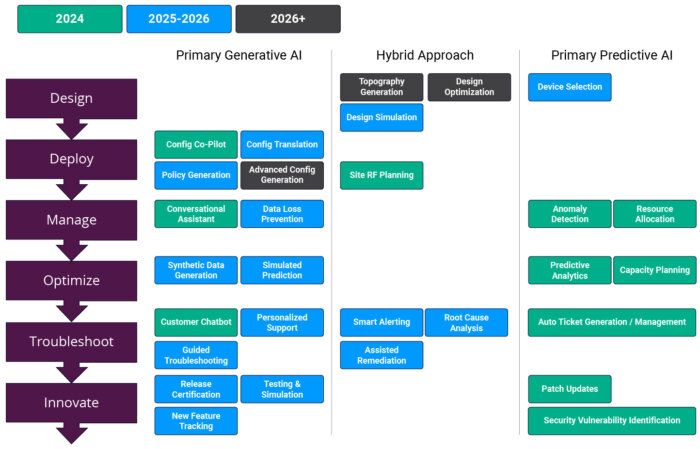Implementing AI technologies to optimize, streamline, and transform the network has been and will continue to be a priority. The promise of autonomous networks has long captured the imagination for those of us in networking, but that remains a long-term vision. Today, leaders must focus on AI implementations that provide value in the near term, while laying the foundations for implementing innovative, transformative solutions as AI matures.
Earlier this year, independent research and analysis firm AvidThink released a report exploring the evolution and future of AI in networking. The report highlights the different ways AI can be implemented across the network lifecycle, barriers to adoption, solutions, and key use cases.
One important takeaway from AvidThink’s report is the importance of adopting use cases that will deliver immediate value and prioritizing ROI, especially over the next 12-24 months. While AI is advancing at a rapid pace, the value of many genAI use cases is not yet fully understood, and the risk of implementation can be high. AI — both genAI and the AI/ML use cases that have been present in networking for some time now — is a transformative set of technologies that can offer significant value, if organizations follow AvidThink’s recommendation and take a phased, value-centric approach.
Unlocking Near-Term Value: AI Networking Use Cases with Proven ROI
“Ultimately, the vision of a fully autonomous network will be in continuous development during a 5-7-year journey that will bring early benefits along the way — AI/ML has already delivered value, and GenAI, in the form of assistive copilots, can provide incremental value with low risk while we mature the technology.” – AvidThink
As highlighted in AvidThink’s report, practical applications of AI — particularly predictive and generative models — are already delivering measurable benefits. Here’s how organizations can begin leveraging AI for networking to achieve quick wins and set the stage for future advancements.
AI-Assisted Network Design
Before a network is even deployed, AI can streamline and optimize the design process. By automating tasks like site planning, topology creation, and device selection, AI helps organizations save time and reduce costs. Using digital twins — virtual models of network elements — network designs can be simulated and validated in risk-free environments. This ensures performance objectives are met before changes are made in production.
Implementing AI/ML and analytics into network design can accelerate deployments with pre-validated configurations and reduce the risk of errors and incidents, delivering an immediate impact on network efficiency and uptime.
Embedding AI into Automation
Deploying a network can be complex and labor-intensive. AI changes this by automating configuration generation, validation, and policy creation. AvidThink’s report estimates that automation of discrete networking tasks assisted by AI agents will emerge as a key AI networking use case over the next 12 months. However, organizations should first look to co-pilot models where human oversight and approval is required for machines to execute new automations. In the future, AI solutions will likely gain the trust and confidence to reach an auto-pilot model, but this is not the case today.
Network Management & Monitoring
According to the report, management and monitoring is the most mature AI networking use case today — AIOps practices have gained significant ground recently.
Once the network is live, managing and monitoring it becomes critical. AI-driven solutions like anomaly detection, smart alerting, and dynamic resource allocation ensure networks operate efficiently. Conversational AI interfaces enhance accessibility, enabling administrators to query and manage networks intuitively. Implementing AI for network monitoring and management will streamline network management and help organizations cut costs right away.
Monitoring is a vital piece of the AI puzzle, and will deliver immediate value. It is also critical for building the future and enabling autonomous networks when we reach that point.
Additional Use Cases
Below is a representation of a graphic from the report showcasing emerging AI networking use cases, mapped to their position on the network design and management lifecycle, and labeled by expected solution maturity. The use cases marked for 2024 are expected to mature quickly and deliver immediate ROI for organizations investing in AI networking solutions.

AvidThink’s Recommendations for Implementing AI in Networking
To unlock the full potential of AI in networking, organizations should adopt a measured, phased approach and look to build on quick wins to lay the foundations for more innovative solutions that are quickly emerging. “The key is to remain flexible and adaptable as the technology evolves rapidly,” the report states. Here are a few of AvidThink’s recommendations for organizations looking to implement AI in the network:
- Begin with proven AI/ML solutions, particularly in areas like anomaly detection, capacity planning, and energy optimization — these use cases will provide immediate value and continue to deliver consistent benefits going forward and supporting other AI networking implementations.
- Adopt a phased approach to GenAI, beginning with low-risk use cases like conversational interfaces for network management platforms. Allow solutions to mature and look for solutions that will deliver real value as you expand to more complex applications over time.
- Focus on use cases with clear ROI. Prioritize specific pain points and tangible benefits to time to value, security posture, configuration compliance, and efficiency.
- Invest in data infrastructure to support AI implementations with robust data collection, storage, and management across the network.
- Implement robust governance, establishing clear policies and procedures for AI implementation. Maintain human oversight as AI capabilities grow.
- Continue to evaluate, iterate, and adjust your approach based on results and emerging technologies.
AI has the power to transform networking, but we’re still a long way away from fully autonomous auto-pilot networks that self-design and self-operate without human input. Today, it’s important for organizations to implement AI across the network to optimize processes and improve network operations, but as the technology evolves, the focus must remain on clear, proven, near-term value — even as we try to stay flexible and adaptable to adopt new, innovative solutions that emerge in the future.
To get more insights on AI in networking and how organizations can best implement AI across the network lifecycle, read the full AvidThink report here. You can also watch Itential’s CTO Chris Wade share his thoughts on how AI is reshaping network infrastructure in this video.





